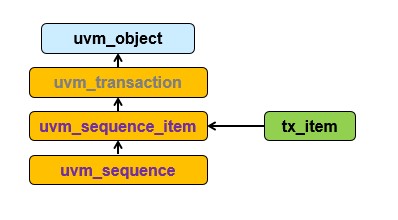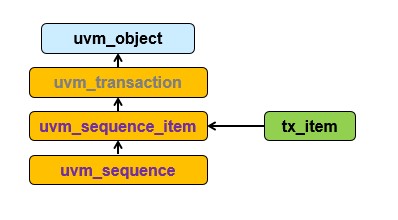Why are UVM transactions built with uvm_sequence_item?

What is a UVM transaction?
A transaction in UVM is a class with properties for the signals, such as address and data, plus extra information such as errors or delays. This is great for sending in one piece of stimulus, but you can’t verify a design with a single transaction. You need groups of related transactions.
What is a UVM sequence?
A group of related transactions in UVM is called a sequence, and the individual members are called sequence items. When you write your transaction classes, extend uvm_sequence_item, not uvm_transaction. Here is the OOP hierarchy for these classes, including your transaction class, called tx_item.

Extend your transactions from uvm_sequence_item
Advantages of uvm_sequence_item
The class uvm_transaction is left over from an older methodology and has no context, no knowledge of being part of a group of transactions. The class uvm_sequence_item has several properties that connect it to the outside world. These properties are not in uvm_transaction. UVM has set()/get() methods for them, so don’t read or write them directly.
- When you send a transaction to a driver, that is called a “request”. For something like a memory read, there is a “response”, which is an object that holds the data coming back from memory. The driver might be processing several requests concurrently and needs to route the response to the proper sequence. The class uvm_sequence_item has a property with the sequence ID so the response is sent to the correct place.
- The UVM sequencer is the “traffic cop” that arbitrates between concurrent sequences that want to send through the same driver. uvm_sequence_item has a handle to the sequencer that you passed to the sequence’s start() method, as in:
my_sequence.start(env.agt.sqr);
- Sequences can be layered, where a single operation could be made of many smaller transactions. A sequence can start other sequences. So every uvm_sequence_item has a handle to its parent sequence, if any.
Conclusion
When you design your UVM testbench, have your transaction classes extend from uvm_sequence_item, not the Jurassic era uvm_transaction.
Sign up now for my October 8 webinar on UVM Sequences. Take your transactions to a new level!
Enjoy your verification journey,
Chris Spear
Keep learning at http://mentor.com/training
Any questions or ideas? https://verificationacademy.com/content/uvm-systemverilog-ask-chris-spear
View my recent webinars including an overview of UVM Transactions.



Comments